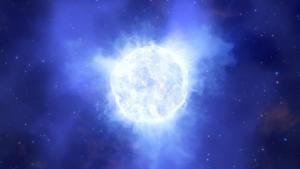A Cosmic Mystery: ESO Telescope Captures the Disappearance of a Massive Star
Using the European Southern Observatory’s Very Large Telescope (VLT), astronomers have discovered the absence of an unstable massive star in a dwarf galaxy. Scientists think this could indicate that the star became less bright and partially obscured by dust. An alternative explanation is that the star collapsed into a black hole without producing a supernova. “If true,” says team leader and PhD student Andrew Allan of Trinity College Dublin, Ireland, “this would be the first direct detection of such a monster star ending its life in this manner.”

A Cosmic Mystery: ESO Telescope Captures the Disappearance of a Massive Star
Between 2001 and 2011, various teams of astronomers studied the mysterious massive star, located in the Kinman Dwarf galaxy, and their observations indicated it was in a late stage of its evolution. Allan and his collaborators in Ireland, Chile and the US wanted to find out more about how very massive stars end their lives, and the object in the Kinman Dwarf seemed like the perfect target. But when they pointed ESO’s VLT to the distant galaxy in 2019, they could no longer find the telltale signatures of the star. “Instead, we were surprised to find out that the star had disappeared!” says Allan, who led a study of the star published today in Monthly Notices of the Royal Astronomical Society.
Located some 75 million light-years away in the constellation of Aquarius, the Kinman Dwarf galaxy is too far away for astronomers to see its individual stars, but they can detect the signatures of some of them. From 2001 to 2011, the light from the galaxy consistently showed evidence that it hosted a ‘luminous blue variable’ star some 2.5 million times brighter than the Sun. Stars of this type are unstable, showing occasional dramatic shifts in their spectra and brightness. Even with those shifts, luminous blue variables leave specific traces scientists can identify, but they were absent from the data the team collected in 2019, leaving them to wonder what had happened to the star. “It would be highly unusual for such a massive star to disappear without producing a bright supernova explosion,” says Allan.
The group first turned the ESPRESSO instrument toward the star in August 2019, using the VLT’s four 8-metre telescopes simultaneously. But they were unable to find the signs that previously pointed to the presence of the luminous star. A few months later, the group tried the X-shooter instrument, also on ESO’s VLT, and again found no traces of the star.
“We may have detected one of the most massive stars of the local Universe going gently into the night,” says team-member Jose Groh, also of Trinity College Dublin. “Our discovery would not have been made without using the powerful ESO 8-metre telescopes, their unique instrumentation, and the prompt access to those capabilities following the recent agreement of Ireland to join ESO.” Ireland became an ESO member state in September 2018.
The team then turned to older data collected using X-shooter and the UVES instrument on ESO’s VLT, located in the Chilean Atacama Desert, and telescopes elsewhere.“The ESO Science Archive Facility enabled us to find and use data of the same object obtained in 2002 and 2009,” says Andrea Mehner, a staff astronomer at ESO in Chile who participated in the study. “The comparison of the 2002 high-resolution UVES spectra with our observations obtained in 2019 with ESO's newest high-resolution spectrograph ESPRESSO was especially revealing, from both an astronomical and an instrumentation point of view.”
The old data indicated that the star in the Kinman Dwarf could have been undergoing a strong outburst period that likely ended sometime after 2011. Luminous blue variable stars such as this one are prone to experiencing giant outbursts over the course of their life, causing the stars’ rate of mass loss to spike and their luminosity to increase dramatically.
Based on their observations and models, the astronomers have suggested two explanations for the star’s disappearance and lack of a supernova, related to this possible outburst. The outburst may have resulted in the luminous blue variable being transformed into a less luminous star, which could also be partly hidden by dust. Alternatively, the team says the star may have collapsed into a black hole, without producing a supernova explosion. This would be a rare event: our current understanding of how massive stars die points to most of them ending their lives in a supernova.
Future studies are needed to confirm what fate befell this star. Planned to begin operations in 2025, ESO’s Extremely Large Telescope (ELT) will be capable of resolving stars in distant galaxies such as the Kinman Dwarf, helping to solve cosmic mysteries such as this one.
Source: European Southern Observatory
- 291 reads
Human Rights
Ringing FOWPAL’s Peace Bell for the World:Nobel Peace Prize Laureates’ Visions and Actions

Protecting the World’s Cultural Diversity for a Sustainable Future

The Peace Bell Resonates at the 27th Eurasian Economic Summit

Declaration of World Day of the Power of Hope Endorsed by People in 158 Nations

Puppet Show I International Friendship Day 2020

